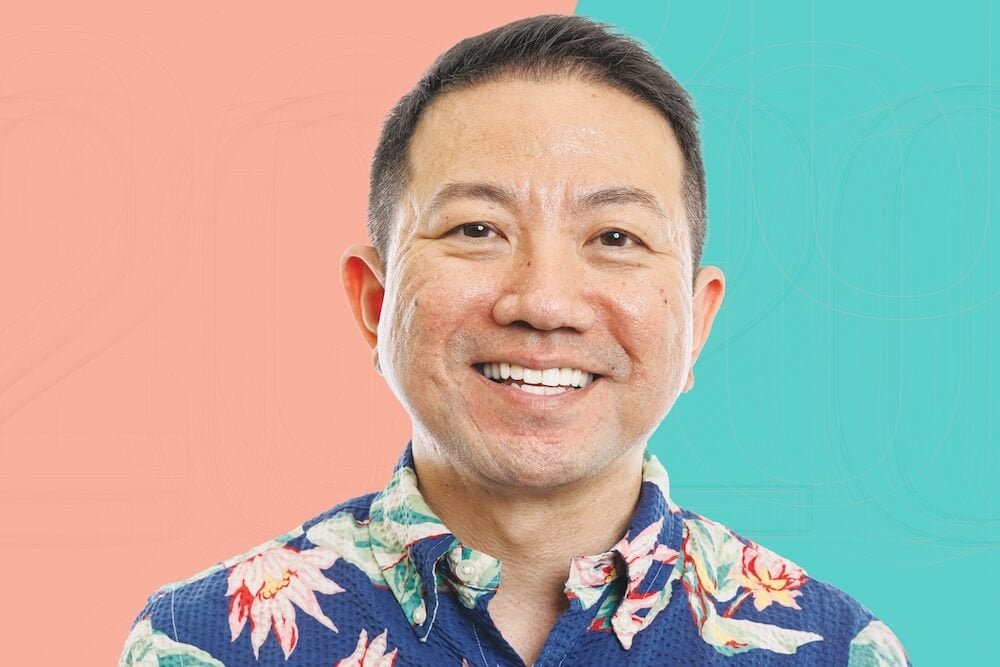Leading Authentically
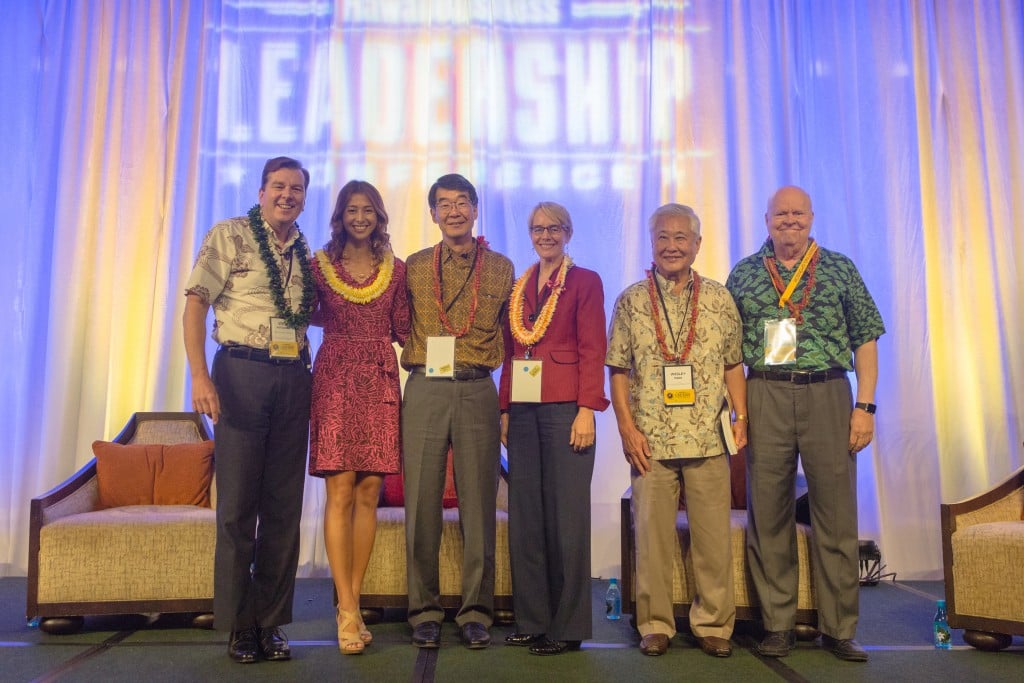
Here is an abbreviated version of the closing session from the 2015 Leadership Conference discussing authentic leadership.
Before the discussion began, the audience was asked to vote via their phones on the most important characteristics needed for authentic leadership. There were six options and here is how the audience ranked them:
- Good listener and collaborator
- Strong network and relationships
- Self-confidence
- Charisma
- Brilliant mind
- Work Experience in Many Areas
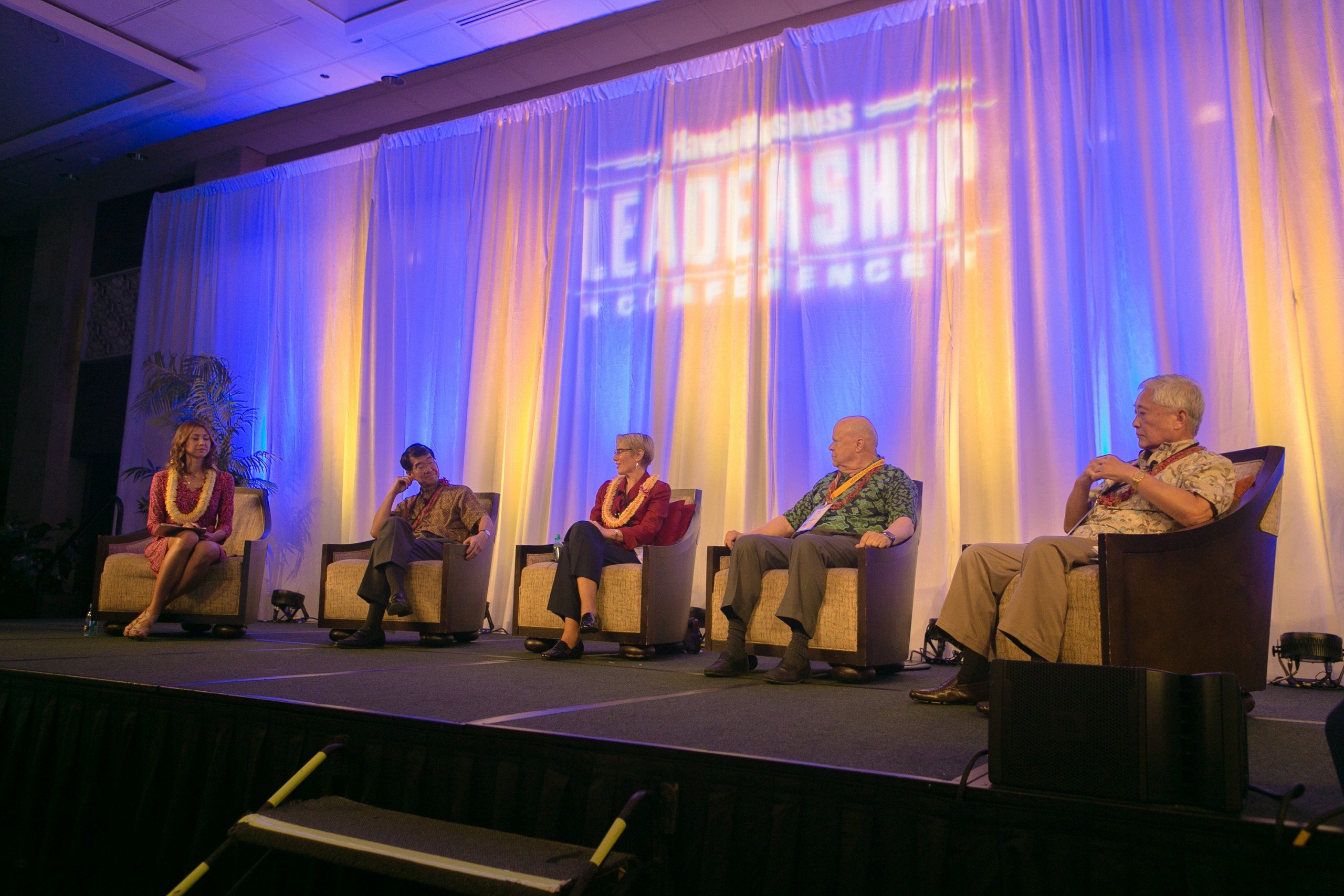
From left: Nicole Velasco, Mark Fukunaga, Virginia Pressler, Walter Dods, Wesley Park
The Participants
- Walter Dods, Former CEO, First Hawaiian Bank
- Mark Fukunaga, CEO, Servco Pacific
- Wesley Park, Former CEO, Hawaii Dental Service
- Virginia Pressler, Director, state Department of Health
- Nicole Velasco (Moderator), Executive Director, Economic Development, City & County of Honolulu
VELASCO: I’d like to hear from our panelists. What do you think about the results from our audience. Mark?
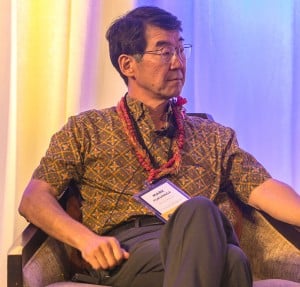 FUKUNAGA: They’re all important, but I think a good listener and collaborator is especially important. You need to make a distinction between leadership and management. Management is about continuing an ongoing enterprise and making sure it runs properly. Leadership sometimes is about managing change and leading change, and you certainly need good listening and collaboration skills to do that. But I think you also need a bit of oomph to really lead. Maybe that’s the self-confidence or the gray matter. And, probably more than anything else, it’s the passion to get where you want to be.
FUKUNAGA: They’re all important, but I think a good listener and collaborator is especially important. You need to make a distinction between leadership and management. Management is about continuing an ongoing enterprise and making sure it runs properly. Leadership sometimes is about managing change and leading change, and you certainly need good listening and collaboration skills to do that. But I think you also need a bit of oomph to really lead. Maybe that’s the self-confidence or the gray matter. And, probably more than anything else, it’s the passion to get where you want to be.
VELASCO: Ginny, which of those has been most important in your career?
PRESSLER: I’m glad to see the audience doesn’t think a brilliant mind or charisma is most important, because I have neither of those. (audience laughter) But I would agree with the audience that being a good listener and collaborator are probably the most important of those listed. If you can’t listen well, and really hear what others are saying, it’s very difficult to develop relationships, common ground and vision so you can work together to accomplish goals.
VELASCO: Walter, I read a quote of yours that said, “Teamwork commands a higher premium than talent.” How do teamwork, listening and collaboration factor into leadership?
DODS: I’ve always said teamwork is the most important thing, that I would take a team player over a superstar, when running a company. There’s room for superstars in certain organizations, but not at First Hawaiian when I was running it. I believe the team approach will always do better. Listening is crucial. Many CEOs or leaders talk when they should be listening, then never learn anything and wonder why things aren’t going the way they want them to go. And I agree with Ginny: You don’t need a brilliant mind if you put good teams together.
VELASCO: Wesley, what do you think has been crucial in your leadership roles?
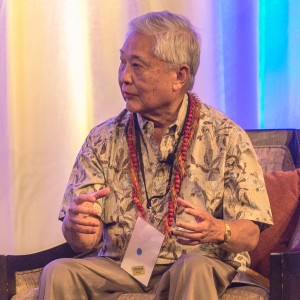 PARK: I’m usually put into troubled situations – have been in all my life – and the most important thing when you walk in the door is to know what the mission is, and what the institution is. Then you’ll know what you have to do and what you can’t do.
PARK: I’m usually put into troubled situations – have been in all my life – and the most important thing when you walk in the door is to know what the mission is, and what the institution is. Then you’ll know what you have to do and what you can’t do.
VELASCO: In our prep session, you also mentioned having deep roots and friendships. How have longstanding friendships helped you?
PARK: Friendship has been everything to me. Walter has helped me a lot all of my life. Even though I’m just a guy from Kalihi, I’ve been very fortunate to have friends like Herb Cornuelle and George Chaplin, who used to be editor of The Honolulu Advertiser. When I got mad at the paper one day, I said, “I’m going to write one letter to the paper.” And George said, “Wesley, never write a letter with a ball point pen to anybody who buys ink by the barrel.” (audience laughter)
Herb Cornuelle’s favorite comment was, “Speak the truth, do what you think is right and, if people don’t like it, write your resume.” In other words, don’t put up with crap, just look for another job. (audience laughter)
WHO ARE YOU AS A LEADER?
VELASCO: Originally, I was going to ask the four of you: What is a leader? But rather, I will pose this question: Who are you as a leader? Mark?
FUKUNAGA: You’ve got to be yourself – probably more important than anything else. You also have to really understand the values of your organization, what you want them to be, what you want to reinforce, because that’s going to drive the energy of the team. And, if you want to accomplish something, believe in it. Through that belief, sincerity and passion, you will energize everybody around you.
But ultimately, I think, if you try to take someone else’s style or try to match some archetypal leadership model, you’re not going to do it. You have to be yourself. I’m an introvert. I’m not naturally out there, but I know I have to be. I know I have to work with my folks and collectively get where we want to go. That’s a muddled answer, but that’s where I am.
VELASCO: Pretty good for an introvert, I’d say. Ginny, you told me once that you never aimed to be anybody but yourself. How has that informed who you are as a leader?
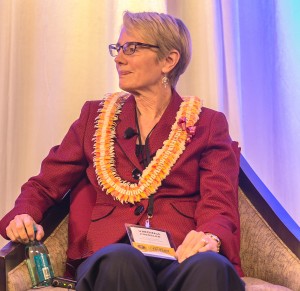 PRESSLER: I would say my leadership style is driven by my personal values. And the values I value most are integrity and respect. No matter what position I’m in and whatever leadership role I’m thrust into, I always try to do it with integrity and respect for the people I’m working with and the people I’m serving.
PRESSLER: I would say my leadership style is driven by my personal values. And the values I value most are integrity and respect. No matter what position I’m in and whatever leadership role I’m thrust into, I always try to do it with integrity and respect for the people I’m working with and the people I’m serving.
VELASCO: How did you discover that leadership identity?
PRESSLER: I think it was inbred from my childhood. My father was my greatest mentor and he had incredible integrity and respect for others. And I think I developed those values as well, and I’ve always been guided by them.
INCORPORATING VALUES INTO LEADERSHIP
VELASCO: Walter, how have you incorporated values into who you are as a leader?
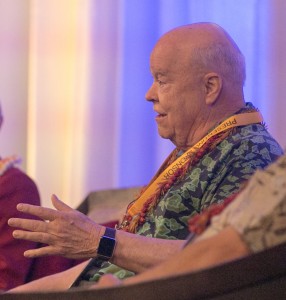 DODS: Before I answer that question, I’m going to talk about the introvert, Mark. I’m sure there are not three people in the audience who know Mark is co-chairman of Fender Guitar nationally. For an introvert, he has Bono as his fellow board director and he also plays the guitar in his spare time. I’m very impressed with that introvert style. So don’t let him kid you. (audience laughter)
DODS: Before I answer that question, I’m going to talk about the introvert, Mark. I’m sure there are not three people in the audience who know Mark is co-chairman of Fender Guitar nationally. For an introvert, he has Bono as his fellow board director and he also plays the guitar in his spare time. I’m very impressed with that introvert style. So don’t let him kid you. (audience laughter)
As you know, leaders come in all shapes, styles, sizes and I’ve kind of spent my whole career studying leadership. I grew up under the F.E.A.R. method of leadership. We had a CEO before me who was just to the right of George C. Patton. (audience laughter)
It was a very interesting education in leadership and, in some ways, it taught me what I wouldn’t want to be as a leader. You have servant leaders, people who lead by example. You have inspirational leaders, and I wouldn’t totally cut charismatic from the list of important leadership traits.
Look at Steve Jobs: If you go by normal leadership characteristics, he would fail in every category. Overbearing, know it all, cut through the stuff and rip everybody’s morale apart and belittle you in front of the troops. Was he a leader? Well, in 20 years, his company became the largest market cap company in the history of the world.
So, you can’t discount that, but you need to find your own leadership style. Something you’re comfortable with. Employees have unbelievable BS detectors and know right away if you’re not being true to yourself and to your style of leadership. You need to find what works for you.
As Mark said, values are important, and values are very important at First Hawaiian. When our generation took over the bank, we were in a poor second place and decided to recast the bank. Changing the leadership or culture of an institution is a very difficult thing. I have concluded after 50 years of business that it’s a three-to five-year-minimum process to change the culture of a large organization. Obviously, quicker in a smaller organization, but changing a culture is so critical, as is making sure everybody buys into that culture.
In First Hawaiian Bank’s culture, Hawaiian is more than our middle name. Our culture had to reflect that we are Hawaiians, and understand and respect that culture. That meant letting the company’s employees know what your goals are, what your direction is and everybody understanding it. There is no such thing as overcommunication when it comes to that.
HOW DO YOU IMPLEMENT YOUR VISION?
VELASCO: How do you properly implement vision for your team?
DODS: First of all, you say it. You say it again. And then you say it again. You start off with a vision. You’ve got to get everyone to buy into it. For everybody to buy into it, they’ve got to believe the vision is real and that you can make it happen. You can’t say in a vision, “We want to be the largest company in the world.” That’s probably not going to work out.
We were very lucky. We found one of the top corporate consultants in the world, a fellow by the name of Ram Charan. He spends 360 days a year traveling around the world, consulting to companies. He helped us coalesce our vision. Sometimes it’s good to bring somebody in from the outside to challenge your points of view. And, once we all bought into it, then we got down to the strategy and everything else. But you’ve got to get buy-in from top to bottom.
I found in my career that the most important thing was communications. A lot of leaders will hold back information from the troops, and once you’ve done that, you’ve wrecked any chance of good leadership and meeting your goals. In our company, the top 40 people meet once a week – everybody reports. Not because we’re going to solve each other’s problems. So everybody can know what everybody else is doing. Once everybody’s marching down the same street, wonderful things start to happen.
VELASCO: Wesley, you’re well-known for a herculean effort to save Hawaii Dental Service. Please tell us about that.
PARK: (At that time, in 1995, Park was a consultant for First Hawaiian Bank and Queen Liliuokalani Trust.) Somebody called and told me they could not find a CEO for Hawaii Dental Services, because it was about to go bankrupt and nobody wants to be the captain of the Titanic. They talked to me for a while. Sharon Weiner said, “I brought your name up and I told them you weren’t no saint, but you could do it.” I thought about it and I talked to Walter, Sharon and other people about it. After awhile, instead of feeling there was no hope for HDS, I thought to myself, “Look for hope,” and I found hope.
So I went through the whole process and there are 25 guys (on the board), half of them dentists, and hardly anybody knows anything about management. Somebody who’s never had muscle and you put them on a board and they’ve got muscle? All of a sudden, they are experts on everything? That was it and they were going broke, but they still thought they were experts. I told Walter, “I’m going to take on the challenge.” He goes, “You don’t have to worry because you can always come to the bank after.” (audience laughter)
I interviewed with, like, 25 people. One question they asked was, “Why would you come over here when you have such a good job?” I said, “Us local guys, sometimes we see the flag waving and we hear the bugle playing. We figure somebody’s got to save it for Hawaii.” Another dentist asked me, “How long do you think you can last?” I said, “I’m going to last until I can fix this place and, once it’s fixed, anybody gives me horseshit, I’m out of here.” (audience laughter)
So after five years, from $3.5 million dollars in debt, we brought it up to $42 million dollars in reserve. We had lost all our clients, they all came back. Thanks to guys like Walter and Larry Johnson (at Bank of Hawaii), big banks set the pace: They came back and everyone else came back. We’ve got a really good company and we have reserves, too. In business, when you have reserves, you make money on the interest. So your reserves become even bigger as years go by. But several dentists on the board decide to give me some horseshit and I was gone. Aloha. (audience laughter)
That was engrained in the way I was raised. I thought about my salary, but then I thought to myself, “I gave my word. And my word was, ‘If anybody gives me horseshit, I’m leaving.’” That was my word. That’s what you learn on the street.
LEADING DURING A CRISIS
VELASCO: I think you answered my next question, which was, How do you maintain authenticity in a crisis? (audience laughter and applause) For our other panelists, could you share a crisis and how you handled it?
FUKUNAGA: For Servco Pacific, one of our big crises was the Toyota recalls in 2010. As you all know, Toyota had this wonderful reputation for quality – thankfully, it still does – but we had a spate of recalls. That’s when leadership really matters, in a crisis managing change and stepping into a crisis, because no one else can do it.
One lesson we learned is that leadership’s changing a bit in the internet age. I’ll give you the scenario: We found out Toyota was closing all its factories because of a recall from the Department of Transportation’s NHTSA (National Highway Traffi c Safety Administration) at about 2 in the afternoon. Toyota was temporarily closing, because you cannot produce a car if you’re under a recall. Yet, I think, all we got from Toyota was a two-sentence fax or email. That was it.
So, 3 p.m., we’re figuring out, “What the heck are we going to do?” About 3:30, we start getting calls from the media. Of course, we don’t know anything other than Toyota is shutting down everything. We decide not to say anything stupid and just say: “We’ll get back to you guys tomorrow when we know more. But we really don’t know much at this time.” That would have been perfectly fine in the old days.
At 6, when the nightly news came on, we weren’t there, but everyone else had an opinion. The corner mechanic, somebody who is a car enthusiast. All of a sudden, they were talking to everybody about us. It was like, one of those dreams when you imagine you’re dead and you’re floating above the funeral. Someone’s giving the eulogy and you don’t really like the eulogy. But you’re up there. That was our situation. We’d kind of lost control.
So, the next morning, we had a first-thing-in-the-morning meeting. We said, “No matter what, we’re going to take our share of space. We’re going to take center stage in this crisis, whether or not we know what the hell we’re saying. Because it’s better that somebody else hears it from us than someone who doesn’t know about it at all and offers an opinion.” As we all know, on the internet nowadays, an opinion can pass as a fact.
Out of all that, we learned it’s more important to be there and, if you don’t have the answer, you at least have the caring and the compassion and the desire to fix things, and you need to convey that. That counts for a whole lot while leading through a crisis.
It’s almost a different formula today. In the old days, you think, you compose, you roll out the script and you perform well. Nowadays, you’ve just got to be out there and show yourself, bare your soul and say, “We’re going to do whatever it takes.” There’s an element of leadership now that requires you to be front and center, pull from your deepest values and beliefs, which is that you’re going to fix this one way or the other. That may be the most important thing.
DON’T HIDE IN A CRISIS
VELASCO: Walter, I see you nodding your head.
DODS: He’s reminding me of my most recent crisis, the molasses spill (a faulty pipe leaked 233,000 gallons of molasses into Honolulu Harbor in September 2013). One of my side hats is being chairman of Matson. When you have something that big, you have lots of people with opinions. And the lawyers are the first with their opinions. The lawyers told our CEO (Matthew Cox), “You can’t admit any liability or guilt of any type, because there’s millions and millions and millions of dollars at stake. So you have to say, ‘No comment.’ ”
For better or for worse, I was the chairman of the company and I had a lot to say about it. I told Matt, “Go tell the lawyers to go shove it up their kuzings.” If you’re Portuguese, you understand what that means. And I said, “No, there are times in life, when you’ve just got to do the right thing as a leader. Not if, and, or but. We put the molasses in the water, we’ve got to clean it up.” So I said, “Matt, you get up there and tell them we’re going to make it right. We’re going to do the right thing, because we caused it to happen.” Now, you can argue how it got in the pipeline and “Didn’t you see it?” Whatever. But molasses is in the water, and it’s causing problems and we’ve got to step up to the plate and call it.
I said, “First thing you do is all the claims from the little businesses that are affected, you get the claims department to work 24 hours a day, and you go out there and you ask, “How much have you lost? Show us your books.” And write them a check.” And, “You do the right thing up front, people are going to respect you for that.”
We still have things that we are working on with the state and a few other areas, so it’s not over yet. But I’ll tell you a very interesting story. We were sued on the mainland under EPA and in federal court. In the end, we won that particular judgment, and the federal government settled with us and said in writing, “One of the reasons that we did it, is because you did not try to stand behind the law and the rules, because you stood up to the plate.” That is a very interesting thing: If you do the right thing, a lot of times it will work out for you. And you just can’t hide, you’ve got to do what needs to be done.
I’ll say one thing about leadership that’s slightly off the crisis subject, but it’s a topical title: “50 Shades of Grey.” That’s what leadership is all about: The rules aren’t black and white. Everybody wants the five rules of being a great leader and the five rules of doing this and that. There’s a lot of gray when you get into leadership. It’s understanding how to figure out that gray and never crossing the lines of integrity, personal responsibility and so forth. But within that, there’s a lot of gray one has to navigate through as a leader.
VELASCO: Check out the book “50 Shades of Grey” and let me know if you find anything about leadership in that book. (audience laughter) Ginny, in government, in public health, working in policy, being in a cabinet with many teams or, rather, many leaders on a single team with the governor, how do you maneuver in a crisis?
PRESSLER: One of the most exciting things about being the director of health is there’s no end of crises. The Department of Health covers not only the traditional public health issues, but also behavioral health, our state mental hospital, emergency medical services and environmental health. I don’t think a day goes by that there isn’t another crisis in environmental health. So, it’s about the things we’ve been saying: Integrity. You can’t hide from it. Even if you don’t know all the answers, the crisis happens, and people are looking for answers. You’ve got to be honest about what you don’t know, and you’ve got to show you care and that you’re dealing with the issue. Communication is absolutely key. It’s quite a challenge making sure everybody’s informed about what’s going on throughout the state.
LEADERSHIP, HAWAIIAN STYLE
VELASCO: What I’ve been hearing throughout is there’s a Hawaii-specific style of leadership. Where does that come from? What does that look like?
FUKUNAGA: In Hawaii, we joke that we’ve got one degree of separation from anybody else here. Nobody talks in the elevator because you never know who’s there. Because of that closeness, you can’t get away with BS-ing people. If you say one thing, but act another way, you’ll be found out. So I think there’s a bit more sincerity. That’s one thing.
The other thing is something we call at Servco our values journey. We work to become very explicit about what Servco stands for. It came out of a conversation about 20 years ago I had with an HR consultant. I asked, “What’s the single most eff ective HR practice?” And he said, “My answer in Hawaii is diff erent from California. California is probably compensation. In Hawaii, it’s values.” There is something to that. People here want to believe in what they are doing, they want to be with other people who believe in what they’re doing. They want to feel good when they go home. A great paycheck is not going to mask not feeling good about what you do.
So I think leadership in Hawaii has to tap into the values of the organization. Figure out which values the organization wants to promote, which ones it wants to discourage and how to make work more fulfilling for everybody, so they feel good about what they do.
VELASCO: What happens when individuals in your organizations don’t share those values?
PRESSLER: Get rid of them. (audience laughter) That’s one of the ways. You either grow the culture or create it. It takes a long time – three to five years, as Walter said – for a large organization to change a culture. You do that by working with people to help them acquire new visions of what they are doing and new ways of working. If they don’t buy into it, they’ve got to go. And you’ve got to be careful as you’re hiring to make sure the new people have values you’re looking for to grow that culture. But you can’t keep people on board who are contrary to the values you are trying to create.
VELASCO: From the different industries you’ve been in – banking, health care, government – are there consistent values you’ve been able to carry through?
PRESSLER: I’ve been in situations where I didn’t share the values of the organization, and that’s when I would leave, because I knew I wasn’t going to change the organization. In other situations, where I had authority, then I tried to get the right people around me and develop common values. Now, common values are not the same thing as being in a bubble that says, “Yes, ma’am. Yes, Doctor. Yes, sir.” It means a team has diverse talents and may not agree with you. But shared values are critical.
VELASCO: Does a team of rivals, or people that don’t agree with you all the time, help to inform the decision-making process?
PRESSLER: Yes. I make sure my team is made up of people who are going to challenge me and not just agree with everything I say. It’s critical.
DEALING WITH ANTAGONISTS
VELASCO: It sounds difficult to maneuver, especially if people fight against what you have to say. Walter, during your long career, I’m sure many individuals went against what you thought was best for the company. How do you manage that?
DODS: One of my senior managers gave a talk and said, “You know, we’re the bank that says yes. And people think that I’m a yes man to Walter Dods. But, I want you to know that’s not true. When Mr. Dods says no, I say no.” (audience laughter)
Values are important, and I agree with everything Ginny and Mark said, so I won’t repeat it. But I serve on about 20 boards or so, including about 10 boards of companies that are fairly significant in our community. And the cultures are all different, but there are underlying things that are the same. The core values are the same. And I call it, “Going local, brah.”
I feel really strongly about this, so let me take a minute to explain what I mean. Going local, in my opinion, doesn’t mean you have to be from Hawaii. It means you have to respect local values. I know people who have lived here their whole lives, who don’t respect local values. And I know people who come off the plane and, in two weeks, have more local values than some people who have lived here their whole lives. Other people come to Hawaii, and they think local means the red carpet room in the Pacific Club. Other people come here and they get into the food, the culture, the personalities, our “local values,” and become very local. I think your values – your personal values and your corporate values – are very important and not everybody believes in those values. So, you need to politely retrain them or move them on. Because they’re going to hurt your organization if you don’t. So, creating a set of values and making sure everybody buys into those values is very important.
VELASCO: Perhaps the most endearing title I’ve heard so far for Wesley Park is, “The local boy’s local boy.” What can you tell this audience about how to maintain local values throughout the process of becoming successful?
PARK: When you talk about local boys, 40 years ago they were a certain kind of guy. Thirty years ago, it was a different kind of guy. Every generation, you have to adjust. We’ve got to adjust to the haoles, because the haoles rule over all. (audience laughter) We’re Americans and we’ve got to adjust to America. For example, political correctness. You can’t even make Portagee jokes, so I changed all the Portagee jokes to Korean jokes. (audience laughter) It constantly evolves. And that’s the culture now, which is part of American culture. We’re still local, but we are changing the way we are local. We have to or the world will pass us by.
When I wrote these books about local culture (“Lessons Learned on Bishop Street” and “Lessons Learned on the Corner in Kalihi”), I wanted to pass the culture on to my children and my grandchildren. One thing I wrote said, “We should listen to lawyers, accountants and CPAs. Listen to lawyers when there’s a legal problem, listen to CPAs when there’s an accounting problem. But in the end, when it’s a management problem, you’ve got to make the decision.” A lot of guys use a cop out: “My lawyer says this. My accountant says this.” Don’t do that. Do what is right. That’s the local way.
PLANNING FOR YOUR REPLACEMENT
VELASCO: I know succession is important to many of you. Is there a succession plan for authentic leadership in Hawaii? Ginny?
PRESSLER: I don’t know if this is a succession plan for Hawaii, but I can tell you my own personal style is that, as soon as I’m in a new role, I’m developing successors. Every place I’ve been, I’ve tried to work myself out of that job and teach people I’m working with to take over so I can delegate to them and do things a little more exciting or different. So, every place I’ve been, at the time that I’ve left, I don’t think I’ve left a huge vacuum. I left on fairly short notice from Hawaii Pacific Health to go to the state because I decided it was the place I needed to be, and I’m glad I made that decision. But it was very short notice. They say they miss me, but I don’t think I created a crisis when I left because I had been working for many years on developing the talent to take over my role.
VELASCO: Here is a question from the audience: What was your single biggest accomplishment and failure? And how did it impact your career? Who wants to volunteer?
FUKUNAGA: Single biggest accomplishment was staying employed. (audience laughter) The failure was that Servco used to be involved in a lot of stuff . I mean, we had 42 different businesses, everything from office equipment to lending, consumer lending to growing plants in Waimanalo to baking muffins that you could buy at 7/Eleven. We thought we could run it all and, gradually, one by one, realized that we are really good at some things, but not at everything.
So, sometimes, you need to be realistic and that’s really hard to do when you’re passionate about your business. But that’s where having outside advisors helps. Walter hits me on the side of the head all the time: “What are you doing?” It’s incredibly valuable to have that outside objective perspective and learn from it. At the same time, you have to have absolute belief that you can do a couple of things really, really well. Balancing those two is the trick.
VELASCO: Biggest success and failure?
PRESSLER: I hope that my single biggest accomplishment is yet to be seen. I have big visions for things we can do for the state, not only in the Department of Health, but working across departments, so we’re integrating social services with health care, and impacting the health outcomes for people in the state way beyond what we have done in the past.
As far as failures, oh, my goodness. There have been plenty. My biggest one, I hesitate to share with a crowd, because I don’t want to identify the organization. But I had made a big change, took a big risk and it ended up being a failure. And it was because I had a board that was full of horseshit. (audience laughter) So I finally told them that and I left.
WHAT DO YOUNG PEOPLE LACK?
VELASCO: That’s going to be one of the major takeaways of this general session. (audience laughter) Walter, the next audience question is: What are the young leaders most lacking today?
DODS: This again goes to being local. People born and raised here often are very bad communicators. I teach at the university all the time and I talk about it constantly. I tell people who come into Hawaii, when you interview locals, you need to be careful because their lack of communication does not indicate their lack of talent. But we were taught, when we were growing up, “Don’t make ass.” So when the teacher asks a question, don’t be the one to raise your hand and answer it. Because you’re showing off .
We were taught as a culture in Hawaii to hang back and let the other person get the glory. But when you don’t speak, people don’t know how good you are. And people always say, “Give them a chance, get them in the door and you’re going to find out that they’re really good.” But getting in that door, getting those right opportunities is still a problem because we fail to communicate. We’ve got to work on that locally. If our people work on that, they’ve got all the other skills they need to go all the way.
VELASCO: That’s one of the interesting paradoxes in our culture: How do we maintain humility and yet pursue higher endeavors? Is there an art to that?
DODS: Yes, there are ways to do it. You can still be humble and get your point across. It’s how you say it. First of all, it’s not I, I, I. If you’ve got an “I” problem, it’s going to be a problem. But there’s still ways to get your point across.
I’m proud to say that one of the best lines I’ve ever written was a line called, “Quiet and effective.” Young people don’t know about it, but George Ariyoshi was governor in a very tough re-election campaign. A national pollster said, “Step down, don’t run. You’re going to be embarrassed. And you’re going to be embarrassed because polls say you don’t communicate and you don’t talk.” To this day, that guy is still a top pollster for the Democratic Party nationally.
I stood up and said, “You’re wrong. In Hawaii, that’s a quality people like. That you don’t talk and you don’t brag and you don’t take credit.” So I said, “I’m going to turn that into a positive.” And we came up with the advertising theme, “Quiet and Effective.” The rest is history. So, there are ways to communicate yourself and still be humble. But to just sit back and say, “People are going to recognize that I’m really talented,” forget it. (audience laughter)
VELASCO: Our next audience question: What is Servco’s secret to consistently being one of the Best Places to Work in Hawaii, as recognized every year by Hawaii Business magazine?
FUKUNAGA: We’re lucky, we have great people and our culture is healthy. One thing we’ve found is culture is not an accident. You have to be very intentional about the culture you want to have in an organization. It starts with values, as we talked about. We’re very explicit about the values Servco stands for. And we’re very collaborative in forming those values. It didn’t come from the top, it was really a bottom-up effort, drafted by our frontline people. But being intentional about it also means everything you do in work has to align with those values. It’s not something you stick on the wall, it’s something that animates and motivates everything you do at work.
We are also manic about measuring stuff. We actually measure our morale. We measure employee engagement once a year, and we tie compensation to those employee satisfaction scores. And that’s from an outside firm; we used to use Towers Watson, we now use IBM Kenexa. But we have third-party tracking of our engagement and reward that in people who can affect it. Overall, I would say, we just try to make it a fun place. We try to make it an informal place, because informality means there’s no stick-up-their-butt types. People are honest. They say what they think. To use someone else’s word, there’s no horseshit. (audience laughter)
Paychecks are important, but, ultimately, it’s about what meaning they take away from eight hours a day at work. That’s a job of leadership: manage the meaning that your folks take away from their workplace. If it’s a good thing, then you’ve done a great job.
BALANCING WORK AND PRIVATE LIFE
VELASCO: We have our last audience question: How do you manage your public role and still have a private life?
PARK: You don’t have to be public unless you want to be. You know everybody else will be public, so let them be public. And just do what you do, have pride in yourself and feel good about yourself, your family and your friends. And have your own little world within the world. If you died tomorrow, those people out there wouldn’t care. That’s my attitude, so that’s how I’m living life.
VELASCO: Walter, anything to add?
DODS: When you’re running a public company, you do have to take on certain responsibilities you don’t want to. They become, sometimes, pretty crucial. At times of my life in my career, I would be out five, six nights a week for years and years at a stretch. It’s a very difficult challenge. People need to decide what they want in their lives and their careers. And, if you want a private life, don’t take a public position. Because you can find some balance, but it’s going to be an imbalance. If you think you can have a successful public career and a successful private life of equal parts, you’re a pretty special person. I haven’t met that person yet.
Each person has to make decisions about which direction they want to go. I say that seriously because not everybody should take the public role. And family does matter. I was fortunate to have a very committed partner, who helped maintain a very good role and I have a wonderful relationship with four kids who I don’t deserve because the public part of my life took me away from them. You have to decide whether that’s worth it or not. It’s a tough role to balance.
VELASCO: Ginny, you also have a family. How do you maintain that balance with so many demanding jobs?
PRESSLER: I agree with both Wes and Walter. For myself, it’s a matter of learning to say no: That I don’t have to be everywhere someone wants me to be all the time. I’ve treasured my private life and my time with my family, so I protect that as well as I can. And because I have limits on what I’m willing to do with my responsibilities at various times, that’s meant compromises in my career. But that was a choice I made. Each person has to make a choice.
I know that many people sacrifice their family and other life to get ahead in their business. I’ve not been willing to do that, so I’ve made some sacrifices in my career in order to have more balance. But there’s no such thing as having your cake and eating it, too. You can’t be superwoman/executive out there 24/7 and have a family life and relationships and friends and relationships with your children. So you have to make choices and sometimes they’re not easy.
VELASCO: Mark, final words on balancing public and private life?
FUKUNAGA: Probably the most important thing is, as Ginny said, setting limits. It’s probably a small place, just because of the demands of our types of positions, but you’ve got to reserve a little private space, somewhere, sometime, for yourself and your family.
VELASCO: Thank you everyone.

